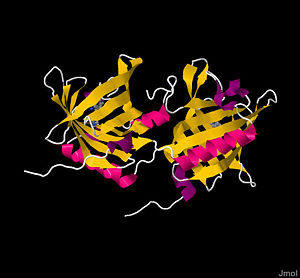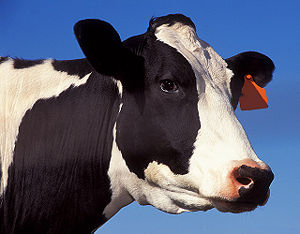homodimer</scene>: The bOBP homodimeric structure, with the first monomer in blue and the second monomer in green.
: C-termini of each monomer, with respective termini in red. Note Termini 2 is in an alpha helical format, while Termini 1 is randomly coiled
' scene='Homodimer/1'/>
Basic Structural Parameters
bOBP is a 159 residue of noncovalently bound, virtually identical monomeric subunits[1][5]. The most significant difference between the two monomers arises at the ; the final amino acids 151-159 form a short α-helix in one subunit and a disordered tail in the other. Although electron densities at the N-termini of each subunit also differ, the underlying structural chemistry is currently unexplained[4]. Other than the aforementioned minor differences, subunits are identical. The total protein itself is small, weighing a mere 19 kDa[1]. Each monomeric subunit consists of eight [1][4][5]. The β-sheets loop tightly to form a β barrel.
β Barrel Active Sites
The β barrels merit further description. Traditionally, a barrel served as an isolated ‘holding cell’ for an odorant. Because most odorants are hydrophobic, the two β barrels’ active sites primarily contain to create a favorable containment environment. These include , , and residues [4]: Ile 22, Phe 36, Thr 38, Phe 40, Phe 54, Phe 56, Val 69, Ala 81, Tyr 83, Asn 87, Phe 89, Ile 99, Ala 101, Asn 103, Leu 115, and Phe 119. The last two amino acids, Thr 116 and Gly 117, use main chain amino groups to form hydrogen bonds with polar odorants. The high fraction of aromatic amino acids allows for “smooth inner walls” that facilitate broad odorant affinity[5]. The subsequent space inside each barrel has a volume of approximately 480 Å[3].
Domain Swapping
The linkages between monomers play crucial roles in forming completed barrels. Each consists of amino acid residues 15-121 from one monomer, which form eight antiparallel β-sheet strands, and residues 145-149 of the second monomer, which form the ninth beta sheet required to complete the barrel[4]. Monomer residues 123-139 (with 126-139 forming an α-helix) of the linking bridge between the two monomers[2]. The final β-sheet of each monomer completes the β barrel of its complementary monomer. This technique is called domain swapping, in which “a swapped domain in a protein oligomer is a globular domain (or sometimes one or a few elements of secondary structure) that is intertwined with an identical protein chain, with the swapped domain having an environment essentially identical to that of the same domain in a protein monomer." This characteristic is allowed by the notable lack of any cysteine residues in bOBP: without cysteines, constraining disulfide bonds do not form and the linking α-helix can snake to its sister monomer’s β barrel to complete the fold[4].
Because of domain swapping, an evaluation of vocabulary is needed: refers to the 1-159 residues of a single unit, whereas refers to residues 1-123 of the first monomer and residues 124-159 of the second monomer[5]. Domain swapping plays a crucial role in regulation. First, by requiring the two monomers to come together to complete a domain, a change in the chemical environment (i.e., a pH change) could prevent the domain swapping and provide a simple regulatory mechanism[4]. This has been confirmed experimentally, in which negatively charged residues of the linking area are titrated at low pH and cause the dimer to dissociate by forming a turn. Second, the connection between the two monomers is a source of negative cooperativity, in which conformational changes in the first domain prevent odorants from binding in the second domain. The entire protein is held together by domain swapping, which utilizes strong noncovalent interactions from the hydrophobic effect; 78% of the ninth β-sheet’s water accessible surface is buried after incorporation into the β barrel[5].
Other Functional Motifs
In addition to the β barrel domains, several other residues have important functions. Residues 57-66 noticeably protrude, likely to aid in receptor recognition. One of the most notable residues is . Phe 89, a flexible residue that can freely rotate[5], may serve as a door for allowing odorants in or out of the β barrel. Note the on the protein's surface where the pink Phe 89 peaks through, implying it acts as a gatekeeper. The residue can rotate approximately 120 degrees around the χ1 bond to prevent clashes with odorants[2]. Phe 89 has been implicated in the negative cooperativity relationship between each domain, in which internal changes caused by odorant binding to the first domain prevent the second domain from binding a second odorant[6].
Physical Properties
Binding Capabilities
Since the odorant binding domains have malleable positions, odorants bind with a wide range of dissociation constants, Kd. Large, hydrophilic, and unsaturated compounds bind poorly to bOBP, a property consistent with those of strong odorants previously described[3]. Spherical shaped molecules also bind poorly[1]. From an evolution standpoint, OBPs do not bind “pleasant” or “unpleasant” smelling odorants preferentially; however, non-odorous compounds typically do not bind to OBPs[3], implying OBPs may factor prominently into determining whether a molecule qualifies as an odorant. Certain chemical motifs do appear to have lower Kd values (stronger binding) than others. Pyrazines, thiazoles, terpenoids, menthols, thymols, aliphatic alcohols, and aldehydes have lower Kd values than round terpenoids, camphors, and polar compounds (like fatty acids)[2]. Despite the wide range of dissociation constants, most Kd values of bOBP are relatively high, often in the micromolar range.
Kinetics
bOBP kinetics studies have scrutinized the once-popular two-site hypothesis where one binding site had high odorant affinity, and the second had low affinity. Although partly true, the currently accepted hypothesis focuses on negative cooperativity: binding one odorant decreases the likelihood of binding a second odorant[3]. Overall, odorant dissociation is fast; this could be advantageous for unloading odorants quickly to interact with receptors and avoid time lapse between odor perception and the chemical signal itself[7].
Because of the odorant sensitivity to pH, the dimer monomerizes at pH 4.5, and the protein as a whole has an isoelectric point of pH 4.7[4].
Functions
Chemical Function
The exact function of bOBP is not well defined. Although OBP primarily transports hydrophobic odorants across the hydrophilic nasal mucosa, this may not be its only role. The first alternative role tributes bOBP with regulating the concentrations odorant concentrations through buffering capabilities[3]. With high Kd values, bOBP can trap odorants more efficiently at high concentration and subsequently narrow the wide range of possible stimuli intensities[1][2]. A second theory expands on bOBPs transporter role, claiming it may mediate odorant signal transduction by interacting with the odorant receptor as an odorant-OBP complex[1].
Evolutionary Roles
Other possible roles of bOBP garner an evolutionarily competitive edge. The ability of bOBP to bind broad molecular classes could have aided the sequestration of cytotoxic or genotoxic compounds for removal or purification[2]. Another particularly interesting hypothesis investigates the , 1-octen-3-ol. Cows secrete this volatile chemical in their breath following stressors like inflammation, temperature, pollutants, or biological parasites. Interestingly, insects utilize 1-octen-3-ol to locate hosts. A possible evolutionary mechanism for bOBP could be binding 1-octen-3-ol to prevent excess insect bites[8].
Functional Relatives
Mutants
To assess domain swapping capabilities, a was engineered with a inserted after position 121. This position was deemed valuable so that negatively charged residues in positions 125-128 could chemically on itself more easily, a crucial event in preventing dimerization. Trp64Cys and His155Cys mutations were also induced to address the importance of in stabilizing the engineered monomer. With these additions, domain swapping was reversed and the ninth β-sheet inserted itself into the monomer’s own β barrel domain. The peptidyl backbones of these residues were superimposable on native bOBP with exception to the backwards ‘hinge’ area and ten final residues at the C-terminus. Through Kd measurements, the mutant bound all tested odorants comparably to the swapped dimer[9].
Protein Relationships
In addition to mutants, bOBP shares some characteristics with other proteins. Notable chemical relatives include mouse urinary protein (MUP). This protein, found in kidneys, shares a similar structure, but does not utilize domain swapping for stability[5]. Many analogous carrier proteins also exist. Most of these proteins are lipocalins, including serum retinol-binding protein and β-lactoglobulin.
When comparing bOBP to other OBPs, a striking sequence difference is discovered: often, less than 20% of the sequence is completely conserved from one OBP to another. bOBP appears to be particularly unique; most lipocalins and other OBPs have cysteines and the associated disulfide bonds, whereas bOBP has neither. In fact, of the four sequences common to almost every OBP, bOBP contains only two: GxW and Yxx-x-YxG[2]. In a class of proteins with already limited conservation, bOBP remains notable.
Summary
Bovine odorant binding protein is a small homodimeric protein found in the nasal mucosa of cows; it has numerous possible functions, including odorant buffering, cellular transduction, insect repellant, and its most important function: odorant transport across the nasal mucosa for delivery to the receptor. bOBP is required for transport because common odorants are traditionally hydrophobic and thus repelled by the hydrophilic layer. To accomplish its many tasks, it binds odorants in a hydrophobic β barrel motif.
References
- ↑ 1.00 1.01 1.02 1.03 1.04 1.05 1.06 1.07 1.08 1.09 1.10 1.11 1.12 1.13 1.14 Pelosi, P. (1994). Odorant-binding proteins. Critical Reviews in Biochemistry and Molecular Biology 29: 199-228.
- ↑ 2.0 2.1 2.2 2.3 2.4 2.5 2.6 2.7 2.8 Tegoni, M., Pelosi, P., Vincent, F., Spinelli, S., Campanacci, V., Grolli, S., Ramoni, R., and C. Cambillau. (2000). Mammalian odorant binding proteins. Biochimica et Biophysica Acta 1482: 229-240.
- ↑ 3.0 3.1 3.2 3.3 3.4 3.5 3.6 3.7 Pevsner, J., Hou, V., Snowman, A.M., and S.H. Snyder. (1990). Odorant-binding protein: characterization of ligand binding. The Journal of Biological Chemistry 265: 6118-6125.
- ↑ 4.0 4.1 4.2 4.3 4.4 4.5 4.6 4.7 4.8 Tegoni, M., Ramoni, R., Bignetti, E., Spinelli, S., and C. Cambillau. (1996). Domain swapping creates a third putative combining site in bovine odorant binding protein dimer. Nature Structural and Molecular Biology 3: 863-867.
- ↑ 5.0 5.1 5.2 5.3 5.4 5.5 5.6 Bianchet, M.A., Bains, G., Pelosi, P., Pevsner, J., Snyder, S., Monaco, H.L., and L.M. Amzel. (1996). The three-dimensional structure of bovine odorant binding protein and its mechanism of odor recognition. Nature Structural and Molecular Biology 3: 934-939.
- ↑ Vincent, F., Ramoni, R., Spinelli, S., Grolli, S., Tegoni, M., and C. Cambillau. (2004). Crystal structures of bovine odorant-binding protein in complex with odorant molecules. Eur. J. Biochem. 271: 3832-3842.
- ↑ Borysik, A.J., Briand, L., Taylor, A.J., and D.J. Scott. (2010). Rapid odorant release in mammalian odour binding proteins facilitates their temporal coupling to odorant signals. Journal of Molecular Biology 404: 372-380.
- ↑ Ramoni, R., Vincent, F., Grolli, S., Conti, V., Malosse, C., Boyer, F., Nagnan-Le Meillour, P., Spinelli, S., Cambillau, C., and M. Tegoni. (2001). The insect attractant 1-octen-3-ol is the natural ligand of bovine odorant-binding protein. The Journal of Biological Chemistry 276: 7150-7155.
- ↑ Ramoni, R., Spinelli, S., Grolli, S., Conti, V., Merli, E., Cambillau, C., and M. Tegoni. (2008). Deswapping bovine odorant binding protein. Biochimica et Biophysica Acta 1784: 651-657.
- Articles 1 and 2 are review articles


